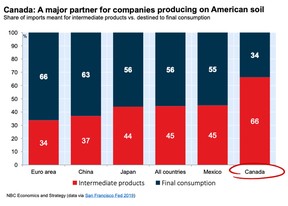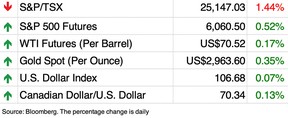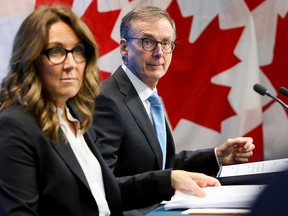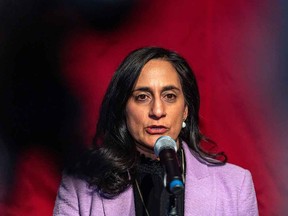Market odds of a cut have dropped to 25%, but this economist makes a contrarian case
Article content

Article content
Article content
The Bank of Canada faces an especially tough decision when the Governing Council meets on March 12.
Not only are U.S. President Donald Trump‘s tariff threats hanging over the economy, but recent data have suggested that the economy — and inflation — are picking up speed.
After a stronger than expected consumer price index reading for January, Canada’s unemployment rate dropped for the second month in a row when job growth tripled expectations.
Advertisement 2
Article content
Three weeks ago markets had fully priced in a 25-basis-point cut for March 12, but since then the odds have shrunk to 25 per cent.
Not all economists, however, agree with the market’s assessment.
“Naturally, these developments leave forecasts for a 25 bp cut next month on shakier footing but there are still some compelling reasons to expect a cut,” said National Bank of Canada economist Taylor Schleich in a report entitled “An increasingly contrarian take …”
Schleich points to the Bank of Canada’s last monetary policy report just three weeks ago, when it said that there were no signs that inflationary pressures were broad-based and even suggested that its preferred indicators were sending a false signal.
The bank also indicated in that report that the jobs market remained soft and members would have to see jobs gains outpacing labour force growth for a longer period to be convinced it was on solid footing.
Schleich has his doubts that January’s 76,000 job gains will change the bank’s mind, when other indicators are showing a different picture.
Hiring intentions are still below historical averages, the job vacancy rate is at a seven-year low and the Survey of Employment, Payrolls and Hours is signalling the opposite of what the Labour Force Survey suggests, he said.
Article content
Advertisement 3
Article content
“To be clear, we don’t think recent inflation/jobs data strengthen the case to cut but we’d argue they aren’t as much of a barrier as markets are implying,” said Schleich.
Economic slack remains in Canada, and the geopolitical uncertainty now circling the globe could widen that gap, he said.
Whether Trump’s tariff threats become reality remains to be seen, but the threats themselves are already having an effect, and according to a Bloomberg survey, economists are trimming their growth forecasts because of it.
They now see the economy growing by 1.6 per cent in 2025, down from a forecast of 1.8 per cent in last month’s survey. The forecast for growth for 2026 is now 1.7 per cent, down from 1.9 per cent.
The Bank of Canada’s own Business Outlook Survey found some companies are holding back on investment because of the trade uncertainty, said Schleich, and a survey by the Canadian Federation of Independent Business found that a fifth of firms were cancelling or delaying plans to expand.
The uncertainty is also weighing on consumers, he said. Last week the Canadian Real Estate Association said a potential trade war with the U.S. was likely the reason home sales slumped in the last week of January.
Advertisement 4
Article content
“The timing of that change in demand leaves little doubt as to the cause — uncertainty around tariffs,” said CREA senior economist Shaun Cathcart.
All of this builds a case for an “insurance cut” from the Bank of Canada which would cushion the blow from tariff uncertainty or tariffs themselves, said Schleich.
The day the Bank of Canada makes its decision Trump’s tariffs on steel and aluminum are due to go into effect and by then there should be some clarity on his border-related tariffs (25-per-cent on all goods from Canada and Mexico).
Schleich said if more evidence emerges that economic growth and inflation are accelerating the central bank will have to change its tone, “but for now, the BoC leans dovish, likely to err on the side of accommodation under uncertainty,” he said.
“We’re not convinced recent data have completely upended that, especially since uncertainty may snuff out any nascent economic recovery.”
Sign up here to get Posthaste delivered straight to your inbox.


As Trump studies the United States’ trade deficit with other nations, economists in Canada hope that this country will be revealed as a vital partner to the U.S. economy.
Advertisement 5
Article content
National Bank of Canada points out that 66 per cent of Canadian exports to the U.S. are actually intermediate inputs in American production, with only 34 per cent of imported goods from Canada intended for final consumption, according to an analysis by the Federal Reserve Bank of San Francisco. As today’s chart shows that is far more the 45 per cent average for other U.S. trading partners.
“Rather than taking market share to win the favour of American consumers, Canadian companies are therefore partners to American companies that produce locally,” said economists Matthieu Arseneau and Stéfane Marion.
“There is a good chance that these firms are already making this point to the American president, who would benefit from recognizing the special nature of his country’s relationship with Canada.”

- Bank of Canada deputy governor Toni Gravelle will speak at the Bank of England research conference in London on managing the central bank’s balance sheet during quantitative tightening
- Canadian taxpayers can start filing 2024 returns online
- Earnings: CI Financial Corp., GFL Environmental Inc., Spin Master Corp., Domino’s Pizza Inc.
Advertisement 6
Article content




Young people in Canada are underusing tax-free savings accounts (TFSAs), even though more than half of the nation’s adult population (17.8 million people) has one, according to the latest numbers from Statistics Canada — and it likely comes down to confusion.
Tara Lalehparvar is co-chief executive officer of Vancouver-based Skyward Financial, a financial literacy and advisory practice geared toward generation Z and younger millennial investors, and she hears a lot of TFSA misinformation from clients, she said.
Find out more about how TFSAs can contribute to a long-term savings strategy.
Calling Canadian families with younger kids or teens: Whether it’s budgeting, spending, investing, paying off debt, or just paying the bills, does your family have any financial resolutions for the coming year? Let us know at wealth@postmedia.com.
Advertisement 7
Article content
McLister on mortgages
Want to learn more about mortgages? Mortgage strategist Robert McLister’s Financial Post column can help navigate the complex sector, from the latest trends to financing opportunities you won’t want to miss. Plus check his mortgage rate page for Canada’s lowest national mortgage rates, updated daily.
Financial Post on YouTube
Visit the Financial Post’s YouTube channel for interviews with Canada’s leading experts in business, economics, housing, the energy sector and more.
Today’s Posthaste was written by Pamela Heaven, with additional reporting from Financial Post staff, The Canadian Press and Bloomberg.
Have a story idea, pitch, embargoed report, or a suggestion for this newsletter? Email us at posthaste@postmedia.com.
Recommended from Editorial
-

Weaker Canadian dollar fuels made-in-Canada backlash
-

How many skipped vacations does it take for a down payment?
Bookmark our website and support our journalism: Don’t miss the business news you need to know — add financialpost.com to your bookmarks and sign up for our newsletters here
Article content
Don’t count Bank of Canada rate cut in March out just yet
2025-02-24 13:00:11







